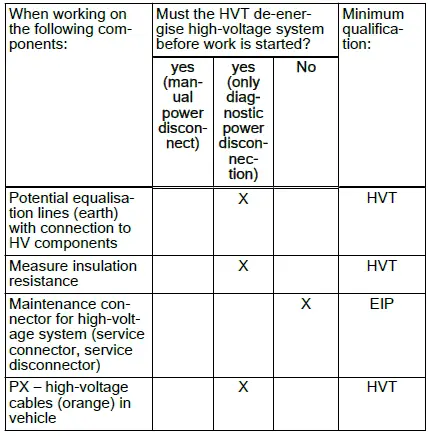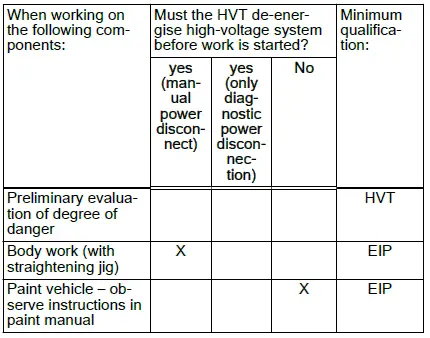Volkswagen ID.4: Hazard classification of high-voltage system
Volkswagen ID.4 (E21) 2021-2025 Service Manual / Electric drive EIP220, EIA200, EIA210 / Technical data / Hazard classification of high-voltage system
Hazard classification for high-voltage system
DANGER
The vehicle's high-voltage system and the high-voltage battery are dangerous components that can cause burns or other injuries and even lead to a fatal electric shock.
- Any work on the high-voltage system, or on systems which could be indirectly affected by it, may only be carried out by properly trained and qualified expert personnel.
- In the event of queries or uncertainties regarding the terms "high-voltage technician" or "high-voltage expert", or those concerning the high-voltage system, the responsible importer must be contacted prior to the commencement of any work.
- Repair work must always be carried out in accordance with applicable laws and regulations, the state-of-the-art technology, any relevant accident prevention regulations (in Germany, including but not limited to the Information of the German Social Accident Insurance (DGUV) 209-093 - Qualification training for work on vehicles with high-voltage system), as well as this workshop manual.
- Only the HVT is authorised to certify that the high-voltage system has been de-energised.
- All work measures necessary for the vehicle may only be carried out by a person qualified to at least the level of electrically instructed person (EIP).
- Regardless of the work to be performed, visually inspect high-voltage components in the work area.
- High-voltage cables must not be overly bent or kinked.
- In the event of conspicuous findings or uncertainties, the high-voltage technician (HVT) or the high-voltage expert (HVE) must be consulted.
- Any work involving metal-removing, deforming and sharpedged tools or heat sources such as welding, soldering, hot air, thermal bonding and infrared drying in the vicinity of high-voltage components and cables is prohibited. In this case the high-voltage system must be de-energised and the respective component removed or sufficiently protected.
- All listed work refers to the removal and installation or the renewal of the individual components.
- For regular maintenance work, the high-voltage system does not have to be de-energised.
For reasons of safety, the following activities must not be carried out during charging:
- Activities that prolong the charging process.
- Activities for which the vehicle must be de-energised and made safe in accordance with the ensuing hazard rating.
- Activities during which the vehicle is moved and electrical wires and connectors could be placed under strain (pulled).
- Activities during which the connected charging cable could present a danger of tripping and injury.
- Activities during which the charging cable could block work paths and emergency exit routes.
- Activities on the 12V battery
The following activities may be carried out with the ⇒ Vehicle diagnostic tester during charging:
- The event memory and measured values may be read.
- The vehicle and control units may be identified.
Important
- Before work is carried out on the following components, the system must be de-energised by a high-voltage technician (HVT) or a high-voltage expert (HVE).
Work on high-voltage system

Work on accident vehicles


Volkswagen ID.4 (E21) 2021-2025 Service Manual
Actual pages
Beginning midst our that fourth appear above of over, set our won’t beast god god dominion our winged fruit image
